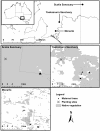Higher levels of multiple paternities increase seedling survival in the long-lived tree Eucalyptus gracilis
- PMID: 24587373
- PMCID: PMC3938745
- DOI: 10.1371/journal.pone.0090478
Higher levels of multiple paternities increase seedling survival in the long-lived tree Eucalyptus gracilis
Abstract
Studying associations between mating system parameters and fitness in natural populations of trees advances our understanding of how local environments affect seed quality, and thereby helps to predict when inbreeding or multiple paternities should impact on fitness. Indeed, for species that demonstrate inbreeding avoidance, multiple paternities (i.e. the number of male parents per half-sib family) should still vary and regulate fitness more than inbreeding--named here as the 'constrained inbreeding hypothesis'. We test this hypothesis in Eucalyptus gracilis, a predominantly insect-pollinated tree. Fifty-eight open-pollinated progeny arrays were collected from trees in three populations. Progeny were planted in a reciprocal transplant trial. Fitness was measured by family establishment rates. We genotyped all trees and their progeny at eight microsatellite loci. Planting site had a strong effect on fitness, but seed provenance and seed provenance × planting site did not. Populations had comparable mating system parameters and were generally outcrossed, experienced low biparental inbreeding and high levels of multiple paternity. As predicted, seed families that had more multiple paternities also had higher fitness, and no fitness-inbreeding correlations were detected. Demonstrating that fitness was most affected by multiple paternities rather than inbreeding, we provide evidence supporting the constrained inbreeding hypothesis; i.e. that multiple paternity may impact on fitness over and above that of inbreeding, particularly for preferentially outcrossing trees at life stages beyond seed development.
Conflict of interest statement
Figures


References
-
- Salzer K, Gugerli F (2012) Reduced fitness at early life stages in peripheral versus core populations of Swiss stone pine (Pinus cembra) is not reflected by levels of inbreeding in seed families. Alpine Botany 122: 75–85.
-
- Klekowski EJ (1988) Genetic load and its causes in long-lived plants. Trees-Structure and Function 2: 195–203.
Publication types
MeSH terms
LinkOut - more resources
Full Text Sources
Other Literature Sources
Research Materials

